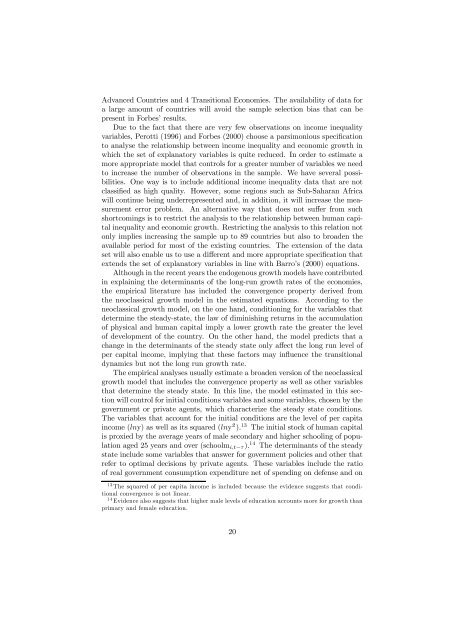Amparo Castelló-Climent, Universidad Carlos III de Madrid ... - Ivie
You also want an ePaper? Increase the reach of your titles
YUMPU automatically turns print PDFs into web optimized ePapers that Google loves.
Advanced Countries and 4 Transitional Economies. The availability of data for<br />
a large amount of countries will avoid the sample selection bias that can be<br />
present in Forbes’ results.<br />
Due to the fact that there are very few observations on income inequality<br />
variables, Perotti (1996) and Forbes (2000) choose a parsimonious specification<br />
to analyse the relationship between income inequality and economic growth in<br />
which the set of explanatory variables is quite reduced. In or<strong>de</strong>r to estimate a<br />
more appropriate mo<strong>de</strong>l that controls for a greater number of variables we need<br />
to increase the number of observations in the sample. We have several possibilities.<br />
One way is to inclu<strong>de</strong> additional income inequality data that are not<br />
classified as high quality. However, some regions such as Sub-Saharan Africa<br />
will continue being un<strong>de</strong>rrepresented and, in addition, it will increase the measurement<br />
error problem. An alternative way that does not suffer from such<br />
shortcomings is to restrict the analysis to the relationship between human capital<br />
inequality and economic growth. Restricting the analysis to this relation not<br />
only implies increasing the sample up to 89 countries but also to broa<strong>de</strong>n the<br />
available period for most of the existing countries. The extension of the data<br />
set will also enable us to use a different and more appropriate specification that<br />
extends the set of explanatory variables in line with Barro’s (2000) equations.<br />
Although in the recent years the endogenous growth mo<strong>de</strong>ls have contributed<br />
in explaining the <strong>de</strong>terminants of the long-run growth rates of the economies,<br />
the empirical literature has inclu<strong>de</strong>d the convergence property <strong>de</strong>rived from<br />
the neoclassical growth mo<strong>de</strong>l in the estimated equations. According to the<br />
neoclassical growth mo<strong>de</strong>l, on the one hand, conditioning for the variables that<br />
<strong>de</strong>termine the steady-state, the law of diminishing returns in the accumulation<br />
of physical and human capital imply a lower growth rate the greater the level<br />
of <strong>de</strong>velopment of the country. On the other hand, the mo<strong>de</strong>l predicts that a<br />
change in the <strong>de</strong>terminants of the steady state only affect the long run level of<br />
per capital income, implying that these factors may influence the transitional<br />
dynamics but not the long run growth rate.<br />
The empirical analyses usually estimate a broa<strong>de</strong>n version of the neoclassical<br />
growth mo<strong>de</strong>l that inclu<strong>de</strong>s the convergence property as well as other variables<br />
that <strong>de</strong>termine the steady state. In this line, the mo<strong>de</strong>l estimated in this section<br />
will control for initial conditions variables and some variables, chosen by the<br />
government or private agents, which characterize the steady state conditions.<br />
The variables that account for the initial conditions are the level of per capita<br />
income (lny) as well as its squared (lny 2 ). 13 The initial stock of human capital<br />
is proxied by the average years of male secondary and higher schooling of population<br />
aged 25 years and over (schoolm i,t−τ ). 14 The <strong>de</strong>terminants of the steady<br />
state inclu<strong>de</strong> some variables that answer for government policies and other that<br />
refer to optimal <strong>de</strong>cisions by private agents. These variables inclu<strong>de</strong> the ratio<br />
of real government consumption expenditure net of spending on <strong>de</strong>fense and on<br />
13 The squared of per capita income is inclu<strong>de</strong>d because the evi<strong>de</strong>nce suggests that conditional<br />
convergence is not linear.<br />
14 Evi<strong>de</strong>nce also suggests that higher male levels of education accounts more for growth than<br />
primary and female education.<br />
20

















